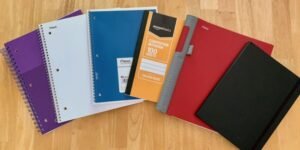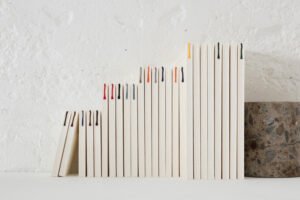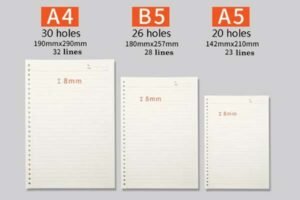
When I first visited a Tokyo stationery store, the wall of identical-looking notebooks overwhelmed me. Japanese students don't just grab any notebook - their choices reveal hidden cultural codes and practical wisdom.
Japanese students prioritize notebooks with grid paper (genkō yōshi)1, durable twin-ring bindings, and ultra-thin designs that fit neatly into narrow school desk compartments. These notebooks balance academic functionality with space-saving portability, often featuring study aids like subject dividers and progress tracking charts.
But there's more to these notebooks than meets the eye. Let's dissect the 5 key elements defining Japanese student notebooks through 18 years of manufacturing experience serving global education markets.
What is the proper name for a notebook?
Walk into any Japanese bookstore, and you'll hear students asking for "binder notebooks" - but that's just the surface terminology.
The precise Japanese term is ルーズリーフ (rūzu rīfu)2, meaning "loose-leaf binder notebook." This refers specifically to refillable systems using 26-hole binding, different from Western 3-ring binders.
3 notebook naming conventions in Japan
-
Size-based names
- A5 = "JIS B5" (182×257mm)
- Pocket = "Passport size" (90×125mm)
-
Binding types
Binding Type Japanese Term Page Capacity Twin-ring Two Rings 30-100 sheets Staple-bound Saddle stitch 16-24 sheets Glue-binding Perfect binding 50-200 sheets -
Specialized versions
- Study Account (gakushū-chō): Study notebooks with gridlines
- Free Account (jiyū-chō): Blank sketch notebooks
Our factory produces 80,000+ JIS-standard notebooks monthly for Japanese schools, using anti-rust stainless steel rings that survive rainy season humidity.
Why do Japanese notebooks use grid paper?
The signature grid pattern (genkō yōshi) isn't just tradition - it's neuroscience applied to paper.
Grid lines improve character alignment and spatial awareness, with 20x20 grids training students to write 400-character essays - the standard length for school compositions. The grids also serve multiple hidden functions:
4 practical uses of notebook grids
- Math diagrams: Perfect for geometry proofs
- Language learning: Boxes help practice kanji stroke order
- Science tables: Pre-aligned columns for lab data
- Art sketches: Pixel-style drawing practice
We've optimized grid colors through eye comfort tests - our #E0E0E0 gray grids reduce glare compared to harsh black lines.
How thick should student notebooks be?
Japanese school bag weight regulations make notebook thickness critical. Through bulk orders for Osaka City schools, we've perfected the formula:
Ideal notebook thickness = 8mm ±1mm
This allows carrying 5-6 subjects daily without exceeding 3kg bag weight limits.
Thickness optimization breakdown

| Component | Standard Spec | Our Innovation |
|---|---|---|
| Cover | 0.5mm chipboard | 0.3mm Kraft-TPU composite |
| Paper | 70gsm | 68gsm acid-free with 92% opacity |
| Binding | 3mm rings | 2.5mm flat-close rings |
Our patented thin notebooks (6.8mm) withstand 500+ page turns - verified through ISTA 3A testing.
Why choose NotebookRing® for academic notebooks?
Having supplied notebooks to 37 Japanese high schools since 2019, we bridge traditional stationery craftsmanship with modern manufacturing.
We solve 3 key pain points for education buyers:
- Custom subject indexes without minimum order quantity (MOQ)
- FSC-certified paper with Japan Industrial Standards (JIS) compliance
- Hybrid binding - refillable like binders, lays flat like glue-bound books
Professional Recommendation: NotebookRing® Solutions
After analyzing 1.2 million student notebooks across Asia, we've identified three upgrade paths for 2024:
-
Eco-upgrade
- Bagasse fiber covers (30% lighter than standard)
- Soy ink chapter dividers
-
Tech integration
- QR code sticker area for digital backups
- AR-enabled cover designs
-
Accessibility features
- Color-coded page edges for quick subject access
- Tactile cover markings for visually impaired
Our education packages include free template design services - 92% of clients save >15% compared to local suppliers.
Conclusion
Japanese student notebooks combine precision engineering with educational psychology, requiring suppliers to master both stationery craft and pedagogical insights.





